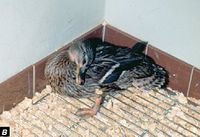Difference between revisions of "Newcastle Disease Virus"
Jump to navigation
Jump to search
| Line 28: | Line 28: | ||
*Infected premises to be culled and firebreak cull if spread | *Infected premises to be culled and firebreak cull if spread | ||
[[Category:Paramyxovirinae]][[Category:Poultry]][[Category:Birds]] | [[Category:Paramyxovirinae]][[Category:Poultry]][[Category:Birds]] | ||
| + | [[Category:To_Do_-_Viruses]] | ||
Revision as of 22:45, 26 June 2010
| This article is still under construction. |
Also known as NDV
Hosts
- Gallinaceous birds, pigeons, parrots, finches
- Subclinical carriers: ducks, ostriches
- Causes conjunctivitis in humans
Pathogenesis
- Transmission via aerosol and direct contact
- Disease ranges from subclinical respiratory tract infections -> torticollis -> haemorrhages and death
Diagnosis
Two diagnostic tests currently exist:
- Animal test:
- Samples of trachea and gut of 20 birds are tested in eggs
- HI using anti-NDV serum (to differentiate HA caused by Avian Influenza
- Virulence of isolate tested by the speed it kills chicks
- DNA test (which will soon replace the animal test):
- Sequencing the cleavage site of H gene
- The more basic amino acids the more virulent the virus
Control
- Newcastle Disease is NOTIFIABLE
- Vaccination of chickens and racing pigeons
- Surveillance of imported exotic birds
- Isolation of infected stock
- Infected premises to be culled and firebreak cull if spread
